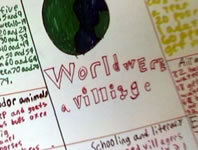 Creative and Inventive Thinking
Creative and Inventive Thinking
"If everyone thinks the same: No one thinks." This saying illustrates the application of creativity in a classroom. Rather than one right answer, creative thinking activities focus on many inventive ideas.
Creative thinking involves creating something new or original. It's the skills of flexibility, originality, fluency, elaboration, brainstorming, modification, imagery, associative thinking, attribute listing, metaphorical thinking, forced relationships. The aim of creative thinking is to stimulate curiosity and promote divergence.
![]() Explore
Teacher Tap: Creative and Critical Thinking.
Explore
Teacher Tap: Creative and Critical Thinking.
![]() Read Creativity & Standards: Amazing Authentic Approaches. This online workshop developed by Annette Lamb provides an overview of ways that media specialists, technology coordinators, and classroom teachers can promote creative thinking and engage young people in creative activities.
Read Creativity & Standards: Amazing Authentic Approaches. This online workshop developed by Annette Lamb provides an overview of ways that media specialists, technology coordinators, and classroom teachers can promote creative thinking and engage young people in creative activities.
In NCREL's enGauge document (DOC) (2003), six categories are identified of Inventive Thinking.
"Experts agree: As technology becomes more prevalent in our everyday lives, cognitive skills become increasingly critical. “In effect, because technology makes the simple tasks easier, it places a greater burden on higher-level skills” (ICT Literacy Panel, 2002: p. 6). The National Research Council’s Committee on Information Technology Literacy defines intellectual capabilities as “one’s ability to apply information technology in complex and sustained situations and to understand the consequences of doing so” (1999: online, Chapter 2.2). These capabilities are “life skills” formulated in the context of Digital-Age technologies.
Inventive Thinking is comprised of the following 'life skills':
- Adaptability/Managing Complexity: The ability to modify one’s thinking, attitude, or behavior to be better suited to current or future environments, as well as the ability to handle multiple goals, tasks, and inputs, while understanding and adhering to constraints of time, resources, and systems (e.g., organizational, technological)
- Self-Direction: The ability to set goals related to learning, plan for the achievement of those goals, independently manage time and effort, and independently assess the quality of learning and any products that result from the learning experience
- Curiosity: The desire to know or a spark of interest that leads to inquiry
- Creativity: The act of bringing something into existence that is genuinely new and original, whether personally (original only to the individual) or culturally (where the work adds significantly to a domain of culture as recognized by experts)
- Risk-taking: The willingness to make mistakes, advocate unconventional or unpopular positions, or tackle extremely challenging problems without obvious solutions, such that one’s personal growth, integrity, or accomplishments are enhanced
- Higher-Order Thinking and Sound Reasoning: Include the cognitive processes of analysis, comparison, inference/interpretation, evaluation, and synthesis applied to a range of academic domains and problem-solving contexts" (enGauge, 2003, p. 27)
![]() Read Teaching for Creativity: Building Innovation through Open-Inquiry Learning by Jean Sausele Knodt in School Library Monthly (May 2010). IUPUI login required. Click PDF Full Text. Find pages 41-44.
Read Teaching for Creativity: Building Innovation through Open-Inquiry Learning by Jean Sausele Knodt in School Library Monthly (May 2010). IUPUI login required. Click PDF Full Text. Find pages 41-44.
![]() Read Key Word: Creative Thinking in THE BLUE BOOK by Callison and Preddy, 349-353.
Read Key Word: Creative Thinking in THE BLUE BOOK by Callison and Preddy, 349-353.
Key Words
Learn More
Creativity Links by C. Osborne. This page links to great resources on creative thinking.
Creativity Pool. This is a database of creative and original ideas. Submit your own or check to see if someone else has thought of the same thing.
Introduction to Creative Thinking by R. Harris from VirtualSalt. This page compares critical and creative thinking and discusses the myths of creative thinking.
